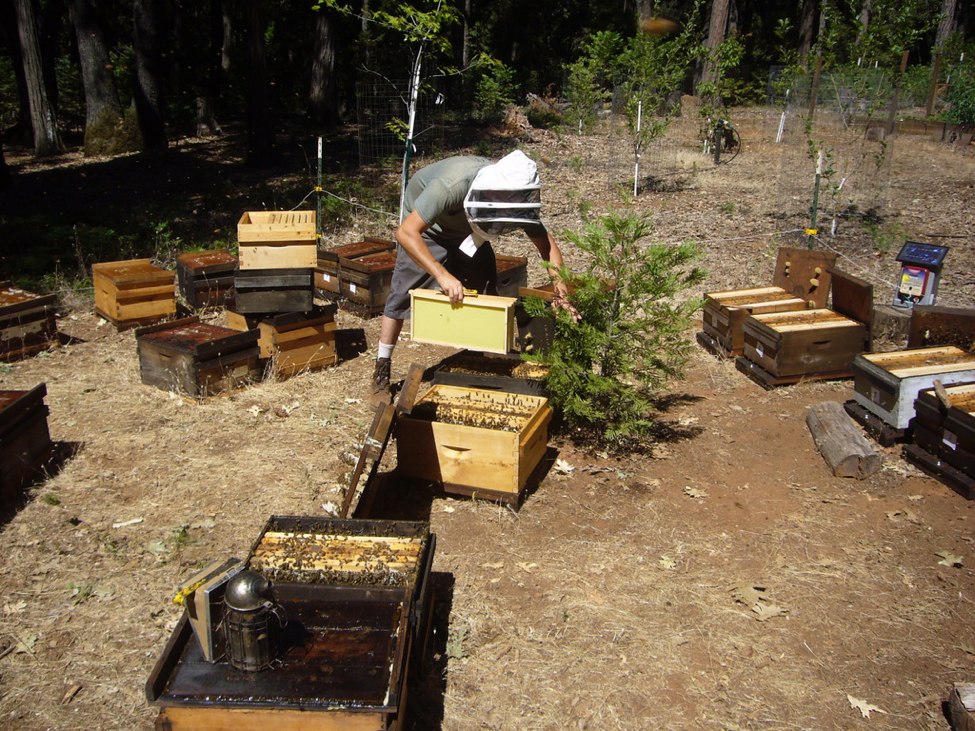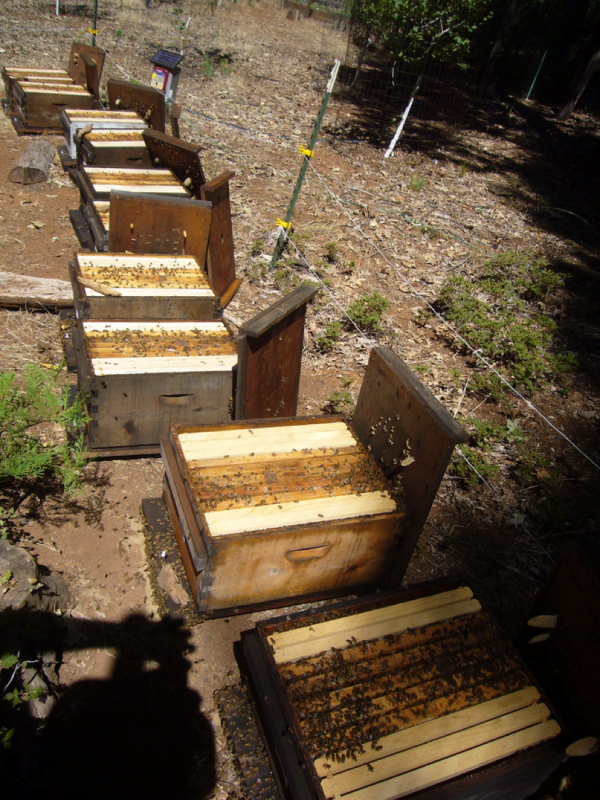Effect of Amitraz on Buildup of Nucs
Effect of Amitraz on Buildup of Nucs
Randy Oliver
ScientificBeekeeping.com
First published in ABJ October 2014
Introduction and Objectives
I was surprised by the slow buildup and lack of drawing of foundation by the nucs in my 2013/14 Pollen Supp Trial. Although the colonies were started during a dearth, due to the near-continual feeding of syrup, I fully expected them to build more rapidly. They didn’t start to build to any extent until shortly after we removed the Apivar strips, but since I had not run a control group without Apivar, I had no way of knowing whether there was any connection.
As I mulled over the question, I came across additional information that furthered my curiosity as to whether amitraz might exhibit negative effects upon colonies (see Amitraz: Red Flags or Red Herrings? in this same issue).
So I decided to run a trial this summer to see whether the application of Apivar strips had a negative effect upon either colony buildup or the drawing of foundation.
Principal Investigator: Randy Oliver, assisted by Eric and Ian Oliver
Funding sources: I hope to be reimbursed for this trial by a grant from the North Dakota Department of Agriculture, solicited for me by the North Dakota Beekeepers Association.
Experimental Design:
- Set up 36 5-frame nucs with freshly-mated tested queens, of two different maternal lines, equalized for strength, in pairs by queen mother. All hives 10-frame deep singles.
- Reduce varroa levels to near nil by “natural” miticides known to leave few persistent residues.
- Randomly assign 1 hive in each pair to receive a single Apivar strip for the duration of the trial (Treatment); open the other hive in each pair but apply no strip (Controls).
- Add 5 frames of foundation and feed colonies for buildup, adding a second box of foundation to all when the first colony drew out its combs in the first box.
- Allow colonies to grow, and then grade them for gain in strength and amount of combs drawn.
Trial Log
June 4, 2014 Moved 20 recently-mated queenright nucs to the test yard, which already contained 20 similar nucs from a different queen mother (both Italian mongrels). All nucs oxalic’d at Day 19; all checked for good patterns of worker brood. The nucs were set in pairs, each pair consisting of two nucs headed by sister queens.
June 6 Equalized all into 5-frames in a single. Typically 4 frames with brood.
June 9 Equalized.
June 12 Equalized and treated all with ½ MAQS.
June 19 Checked one hive for mites—4 in ½ cup bee sample–too many.
June 20 Equalized. Treated all with 1 Hopguard II strip.
June 27 Colonies drawing and filling foundation well. Large hive-to-hive variation in the amount of chewed Hopguard paper at the front of hives. Took composite mite samples of ½ cup of bees from 6 pairs of hives. Only 2 mites total in >1800 bees.
June 30 Final equalization of colonies, checked for queenrightness (2 colonies superseding, removed them and 2 others from trial), removed excess frames of bees, leaving each colony with 5 frames of brood, covered solid with bees. Good nectar flow on.
Experimental note: These nucs were considerably stronger than those in the previous trial, since they started with 5 full frames of brood. The experiment also began earlier in the season (July 1 vs. Aug 8), and during a nectar flow rather than a dearth.
July 1 Time Point 0 Good nectar flow on. Overnight, nearly every colony had built several combs underneath the lids (Figs. 1, 2, and 3).
 Figure 1. All colonies were vigorously drawing comb on a natural nectar flow and ready to rock and roll. Remains of Hopguard II strip visible.
Figure 1. All colonies were vigorously drawing comb on a natural nectar flow and ready to rock and roll. Remains of Hopguard II strip visible.
 Figure 2. Colonies were in pairs, each pair headed by sister queens. We flipped a coin to decide which of each pair received an Apivar strip, and inserted one strip near the center of each treated hive. Here’s Ian adding the frames of wax-coated plastic foundation to the 5-frame nucs.
Figure 2. Colonies were in pairs, each pair headed by sister queens. We flipped a coin to decide which of each pair received an Apivar strip, and inserted one strip near the center of each treated hive. Here’s Ian adding the frames of wax-coated plastic foundation to the 5-frame nucs.
 Figure 3. Start of trial, treatment randomly assigned to each pair. I would have preferred a less-crowded test yard, but this one was near home.
Figure 3. Start of trial, treatment randomly assigned to each pair. I would have preferred a less-crowded test yard, but this one was near home.
July 7 Spot checked. Some colonies drawing foundation, nectar flow tapering off. Fed each colony ½ gal of 1:1 sucrose syrup.
July 21 All colonies appeared strong and building. The strongest had all 10 frames drawn and were heavy; the weakest had not yet drawn all 10 frames, nor covered them. The main flow is tapering off. Fed ½ gal 1:1 sucrose syrup. Added deep super of foundation to each colony.
Experimental note: the strong nectar flow after the start of the trial was unexpected, based upon the previous history of this yard.
July 24 Fed ½ gal 1:1 sucrose syrup.
Aug 8 Time Point 1 Main flow appears to be over, but still mixed pollens coming in. Since there were large differences in strength, we decided to perform the end point assessment. Graded all colonies (by Randy) in morning (by 9:15), blinded as to treatment. Graded for seams of bees and number of well/drawn combs of foundation (out of possible 15).
Results
The final grading took place at Day 38. The Control colonies averaged 8.8 (SEM 0.3) seams of bees; the Apivar-treated colonies averaged 8.5 (0.3). There was no significant difference between the two (Mann-Whitney p = 0.61), as reflected in the histogram of colony strengths in Fig. 4.
 Figure 4. There was no apparent difference in buildup due to treatment with Apivar.
Figure 4. There was no apparent difference in buildup due to treatment with Apivar.
There was no difference between groups in the number of combs of foundation drawn– 5.9 (SEM 0.6) in the Controls; 5.7 (0.5) in the Apivar-treated group.
Discussion
The application of one Apivar strip to a strong 5-frame nuc on a decent nectar flow did not appear to inhibit either colony buildup or the drawing of foundation. I am toying with continuing this trial, periodically replacing the Apivar strips, through next spring, to see whether there are any other observable effects upon the colonies.
Acknowledgements
Thanks to Bonnie and Brent Woodworth and the North Dakota Beekeepers Association for their support of my research.



